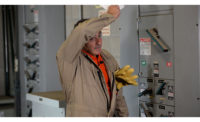Heat hazards can be deadly
Technology helps protect against powerful summer sun

Most companies employ measures to mitigate heat stress on the job. These may include hydration, lighter clothing and PPE, more frequent breaks, and monitoring urine color. And while all of these are important, the truth is that these measures alone won’t cool down a body that has begun to overheat. Even a lightly clothed and hydrated person can experience heat stroke if they continue to work in an overheated state.
The CDC tells us that “simply stopping hard work will not result in an immediate decrease” in body temperature. The agency recommends allowing workers to take breaks in a cool environment like an air-conditioned room or a cooler shaded area to cool people down. But what about working environments where these ideal conditions aren’t available? While cold water is a must for any safe work site, air conditioning isn’t always available and shade isn’t always cool, particularly for sites that are remote or very hot.
A slow-moving hazard
Unlike cuts and lacerations, or slips and falls, all of which can happen very quickly — nobody made one bad decision and suddenly found themselves dangerously overheated. It takes time for heat illness to happen and it’s 100% preventable if you put the right measures in place and/or your team recognizes the signs and symptoms and treats them quickly. In spite of this, more than 11 workers succumb to heat illness every day in the United States. These injuries affect thousands of workers and cost employers millions of dollars.
Technology to the rescue
For workers toiling in unforgiving conditions like summer construction, pipeline work, unairconditioned manufacturing facilities, or forges, the ideal situation is for workers to have a source of body cooling available to them at all times. New cooling solutions employ different technologies to keep workers safe.
Cooling technology
The latest cooling products on the market are just what you’d expect — technology that’s activated by adding water. Not to be confused with older water-activated towels, this new technology uses fabrics specially woven to harness the natural power of evaporation. That means no slimy chemicals to leave a residue on the skin from a garment that gives out after a half hour in the heat. These garments feel almost like a magic trick as they can be activated with any temperature of water – even very hot water. The user simply soaks the garment, wrings out the excess water, and snaps or waves the fabric in the air. The result is a garment that cools down as low as 30 degrees below average body temperature in less than a minute, and stays cool for up to two full hours.
This provides an enormous advantage over other body cooling products as it can be reactivated again and again throughout the day from just about any source of water. So you can save your cold drinking water for hydration and use water from a hose or even from partially consumed water bottles that may no longer be palatable to activate the technology. The activation speed and portability mean that workers don’t have to wait for a break to refresh, they can do it anytime they need it. The technology also comes in various forms to fit different jobs. Cooling towels are the classic, but you can also purchase neck gaiters, bandanas, and skull caps that fit under hard hats.
Sweat management
For some jobs like those performed in very humid environments or jobs that involve electrical work, it’s impractical or unsafe to use body cooling gear that requires added water. For these instances, there is a special material that is activated by the body’s own sweat.
These fabrics are constructed with a patent-pending wicking process that pulls sweat and heat away from the wearer’s skin and passes it through to the outside of the garment. That means the skin-side of the fabric is dry to the touch while the outer layer dries through evaporation. The heat and moisture release helps the worker’s body to remain at a safe temperature, so sweaty workers end up dry and cool instead of overheated and wearing a sweat-soaked garment.
The beauty of this technology is that it’s a solution for both hot and cold conditions. Whether outside in the winter or working indoors in cold rooms or freezers, employees often work up a sweat underneath their cold weather gear, putting them at risk of hypothermia as moisture against the skin can lower body temperature. A base layer of VaporActive fabric keeps sweat and moisture away from the skin to keep the wearer safe and warm.
Keep the old, add the new
This is not to say that you should rely on new body cooling technologies alone. The tried and true methods are still part of your toolbox. Keeping ice cold water available at all times, choosing the lightest possible PPE that offers the right level of protection from hazards, more frequent rest breaks in the shade, and monitoring urine color are all still crucial for safety. In addition, make sure your workers are properly trained in heat safety and that they know to look out for symptoms of heat illness in themselves and each other. A good mix of the old and the new will help to keep your people safe, comfortable, and productive..
Looking for a reprint of this article?
From high-res PDFs to custom plaques, order your copy today!








